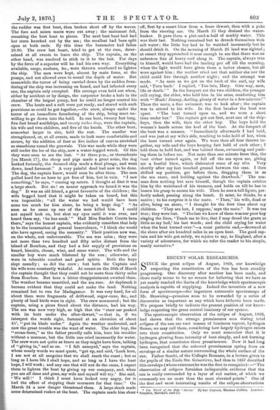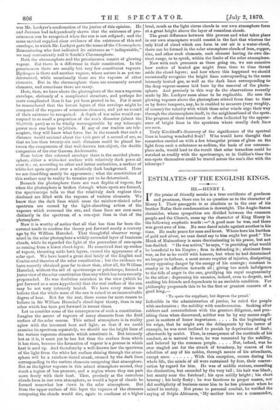RECENT SOLAR RESEARCHES.
SINCE the great eclipse of August, 1868, our knowledge respecting the constitution of the Sun has been steadily progressing. One discovery after another has been made, and
there really seems to be no reason for believing that we have as yet nearly reached the limits of the knowledge which spectroscopic analysis is capable of supplying. Indeed the invention of a new form of spectroscope—the ingenious automatic spectroscope of Mr. Browning—promises soon to be rewarded by a series of discoveries as important as any which have hitherto been made. We propose briefly to indicate the present position of our know- ledge respecting the great central luminary of our system.
The spectroscopic observation of the eclipse of August, 1868, had shown that the strange prominences seen during total eclipses of the sun are vast masses of luminous vapour, hydrogen flames, we may call them, considering how largely hydrogen enters into their constitution. Only we must remember that it is hydrogen glowing from intensity of heat simply, and not burning hydrogen, that constitutes these prominences. Now it had long been recognized that the coloured prominences spring from an envelope of a similar nature surrounding the whole surface of the sun. Father Secchi, of the Collegio Romano, in a lecture given to the pupils of the Ecole Ste. Genevieve, had thus in 1867 described this envelope (whose existence he was the first to recognize) :—" The observation of eclipses furnishes indisputable evidence that the sun is really surrounded by a layer of red matter, of which we commonly see no more than the most elevated points." One of the first and most interesting results of the eclipse observations • The Wreck of the Ship &rim" Simpkin, Marshall, and Co.
By her Captain, Thomas Cubbin. London :
was Mr. Lockyer's confirmation of the justice of this opinion. He and Jannsen had independently shown that the existence of pro- minences can be recognized when the sun is not eclipsed ; and the same method supplied clear evidence of the existence of this red envelope, to which Mr. Lockyer gave the name of the Chromosphere. Remembering who first indicated its existence as "indisputable," we may conveniently call it Secchi's Chromosphere.
Both the chromosphere and the prominences consist of glowing vapour. But there is a difference in their constitution. In the prominences there are usually but very few constituent vapours.
Hydrogen is there and another vapour, whose nature is as yet un- determined, while occasionally there are the vapours of other elements. But in the chromosphere there are commonly several elements, and sometimes there are many.
Here, then, we have above the photosphere of the sun a vaporous envelope, obviously of a complicated structure, and perhaps far more complicated than it has yet been proved to be. For it must be remembered that the lowest layers of this envelope might be composed of the vapours of numerous elements, and yet no record of their existence be recognized. A depth of ten miles would cor- respond to so small a proportion of the sun's diameter (about the 85,000th part) as to be wholly unrecognizable by any telescopic power men can hope to :obtain. If any of our readers are tele- scopists, they will know what force lies in the remark that such a distance would subtend about the 44th part of a second of arc, so that no less than twenty-six such distances could be placed be- tween the components of that well-known test-object, the double companion of the star Gamma Andromedm.
Next below this coloured envelope there is the mottled photo- sphere, either a white-hot surface with relatively dark pores all over it ; or, according to other and better authorities, a surface of white-hot spots spread over a relatively dark background. Here we are describing merely its appearance ; what the constitution of this surface may in reality be remains yet to be determined.
Beneath the photosphere there are vast depths of vapour, for when the photosphere is broken through where spots are formed, the spectroscope tells us that the relatively dark regions thus disclosed are filled with the vapours of various elements. We know that the dark lines which cross the rainbow-tinted solar spectrum are caused by the light-absorbing action of the vapours which surround the sun, and these lines are seen more distinctly in the spectrum of a sun-spot than in that of the photosphere.
Now it is worthy of notice that all that has thus far been dis- covered tends to confirm the theory put forward nearly a century ago by Sir William Herschel. That thoughtful observer recog- nized in the solar photosphere a widely-extended layer of luminous clouds, while he regarded the light of the penumbrm of sun-spots as coming from a lower cloud-layer. He conceived that up-rushes of vapour, thrusting aside both layers, caused the appearance of a solar spot. We have heard a great deal lately of the English and Continental theories of the solar constitution ; but the evidence we have recently obtained goes far to show that, after all, Sir William Herschel, without the aid of spectroscope or polariscope, formed a juster view of the solar constitution than any which has been recently propounded. He was doubtless mistaken in the view (which he put forward as a mere hypothesis) that the real surface of the sun may be not very intensely heated. We have every reason to believe that the whole mass of the sun is raised to an inconceivable degree of heat. But for the rest, there seems far more reason to believe in Sir William Herschel's cloud-layer theory, than in any other which has been put forward in recent times.
Let us consider some of the consequences of such a constitution. Imagine the ascent of vapours of many elements from the fluid surface of the solar oceans. This mixed atmosphere is in reality aglow with the intensest heat and light, so that if we could examine its spectrum separately, we should see the bright lines of the various vaporous elements which constitute it. But intensely hot as it is, it must yet be less hot than the surface from which it has risen, because the formation of vapour is a process in which heat is used up. And therefore by a well-known law the spectrum of the light from the white hot surface shining through the atmo- sphere will be a rainbow-tinted streak, crossed by the dark lines corresponding to the various elements composing that atmosphere.
But as the lighter vapours in this mixed atmosphere ascend, they reach a region of less pressure, and a region where they can part more freely with their heat. Thus, precisely as the cumulous clouds form in our own atmosphere, so would a layer of clouds be formed somewhat low down in the solar atmosphere. But from the upper surface of this layer the vapours of the elements composing the clouds would rise, again to condense at a higher level, much as the light cirrus clouds in our own atmosphere form at a great height above the layer of cumulous clouds.
The great difference between this process and what takes place in our own atmosphere would consist in the fact that whereas the only kind of cloud which can form in our air is a water-cloud, there can be formed in the solar atmosphere clouds of iron, copper, zinc, and other such elements, each element having its own dis- tinct range, so to speak, within the limits of the solar atmosphere.
Now with such processes as these going on, we can conceive how rushes of heated gas might from time to time thrust aside the cloud-layers ; and how where this happened we should occasionally recognize the bright lines corresponding to the more intensely heated gas, as well as the dark lines corresponding to the deep vapour-masses laid bare by the removal of the photo- sphere. And precisely in this way do the observations recently made by Mr. Lockyer seem alone to be explicable. He sees the glowing vapours above the photosphere stirred from time to time as by fierce tempests, nay, he is enabled to measure (very roughly, of course) the velocity with which these solar winds urge their way through the chromosphere itself, in the neighbourhood of the spots. The progress of these hurricanes is often indicated by the appear- ance of bright lines in the spectrum where usually dark lines are seen.
Truly Kirchhoff's discovery of the significance of the spectral lines is bearing wonderful fruit"! Who would have thought that researches carried on with a few triangular prisms of glass on the light from such a substance as sodium, the basis of our common- place soda, would lead to the result that solar tornadoes could be watched as readily with the spectroscope, as in Galileo's time the sun-spots themselves could be traced across the sun's disc with the telescope ?































 Previous page
Previous page